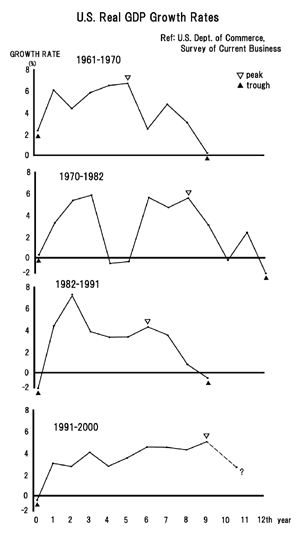The Merits of the Growth Cycle Model: Will the U.S. Face a Recession?
Miyohei SHINOHARA (President Emeritus, Association of Business Cycle Studies)
When you depict the growth cycle path of the post-war American economy in terms of real GDP growth rate, you can clearly see several medium-term cycles with a 9 to 12 year interval between the troughs of each cycle (see the attached graph). From this fact, one can draw the conclusion that the growth recession, that is from a peak to the subsequent trough, tends to last for 3 to 4 years.
 Although some observers say that the American economy will make a V-shaped recovery, I think that will not be the case in view of past history. It seems customary in the postwar period that after experiencing a medium-term boom in capital investment the economy goes through a certain period of downward adjustment in terms of economic growth rate, that is to say, "growth retardation," whereas in the prewar period a decline in the absolute level of output would have been expected. Although some observers say that the American economy will make a V-shaped recovery, I think that will not be the case in view of past history. It seems customary in the postwar period that after experiencing a medium-term boom in capital investment the economy goes through a certain period of downward adjustment in terms of economic growth rate, that is to say, "growth retardation," whereas in the prewar period a decline in the absolute level of output would have been expected.
Whatever the case might be, the U.S. investment boom lasted for about ten years in the 1990s. Since the duration of the recovery period in the short-term cycle used to be between 45 months and 12 months, some observers have regarded the American boom in the 90s as exceptional and called it a "peculiar cycle" ("America's Economy--What a peculiar cycle--," The Economist, March 10th, 2001). In my opinion, however, the ten years of investment boom in the U.S. should not be compared with the recovery period of the short-term cycle, but with the "medium-term recovery period" in the past. For this reason I am particularly interested in 10-year growth cycles in the medium term, rather than a commonly used benchmark for short-term cycles and fluctuations, as indicated by the composite index.
While we are hearing various, rather moody, arguments whether the current downturn in the U.S. economy will be V, U or L-shaped, as students of business cycles we must investigate empirically the patterns of business fluctuations for the past fifty years. In order to analyze the aftermath of a prolonged investment boom we need to employ an analytical model that focuses explicitly on medium-term business cycle patterns. What I have in mind is a simple model of medium-term real GDP growth cycles. Such a model shows a recession period of three to four years in each cycle, a common pattern of medium-term growth recession in the past.
However, an objection to my argument may immediately be raised, that is, an entirely different pattern of business fluctuations from the past might well emerge this time due to the impact of the IT revolution. That would be a model of the new economy without recession. While the number of such new economy advocates is currently declining sharply, many observers seem to believe that the U.S. will make a V-shaped recovery by the end of this year. Also some people are insisting that because the inventory cycle will lose its significance under the IT revolution, there should no longer be business fluctuations due to over- or under-accumulation of inventories.
In the IT revolution, however, firms on the demand side in "B to B" transactions will remain oligopolistic, while the "supply" of new IT input may become limitless. Therefore, the "oligopsony" or "oligopolistic buyers" might well dominate. As a result, the stronger the impact of the IT revolution and the longer the resultant investment boom may be, the sharper will become the declines in the prices of info-telecommunication services and also in the rates of return and stock prices for IT industries.
This should not be regarded as a downturn in the inventory cycle, but rather as a drastic decline in the price cycle. There used to be "silicon cycles" before the IT revolution, but I believe an extended version of such cycles will emerge in the IT revolution.
Just as the "digital divide" (a widening gap in income distribution) is attracting much attention during the IT revolution, there will be "digital restructuring" between new and old sectors with regard to resource allocation and industrial organization. Furthermore, regarding business cycles, "digital recession" will emerge as pointed out above. The impacts that are common to income distribution, resource allocation and business cycle dynamics may well lead to a modern version of "creative destruction" (a la Schumpeter), which large-scale innovation can bring. As I think of the current U.S. situation this way, the V-shaped recovery argument seems to me to be based only on the current "mood," lacking economic analysis.
|





